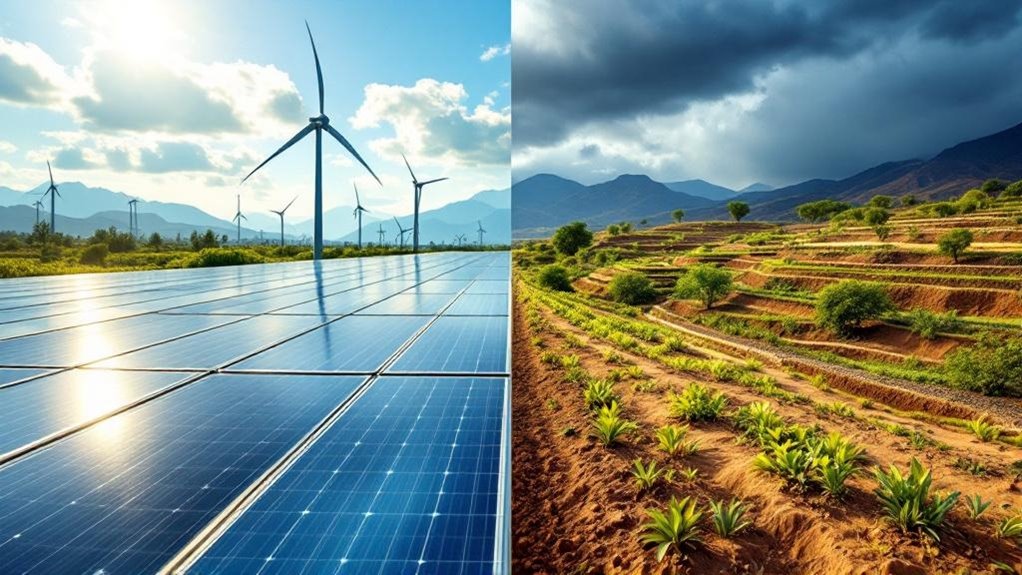Climate finance encompasses the mobilization and allocation of financial resources for climate change initiatives through public sources, private investments, and market-based instruments. Key frameworks include the UNFCCC mechanism and COP29’s NCQG commitment targeting USD 300 billion annually by 2035, while major players like MDBs and the Green Climate Fund facilitate implementation through various financial instruments including green bonds and concessional loans. This complex ecosystem of funding mechanisms and stakeholders forms the foundation for understanding modern climate finance operations.
Defining the Building Blocks of Climate Finance

The complexity of climate finance necessitates a clear understanding of its fundamental building blocks and operational framework. At its core, climate finance encompasses the mobilization and strategic allocation of financial resources across local, national, and transnational levels to address climate change through both mitigation and adaptation initiatives.
This thorough framework operates through diverse funding mechanisms, including public sources, private investments, and innovative market-based instruments. Financial flows are structured to meet strict additionality criteria, ensuring that supported projects deliver genuine climate benefits beyond business-as-usual scenarios while maintaining environmental integrity. The Standing Committee on Finance coordinates and enhances the coherence of climate financing efforts across various mechanisms and entities. Effective implementation relies on country ownership principles to ensure harmonized processes and responsiveness to local needs.
Success in climate finance deployment requires robust institutional arrangements, clear accountability measures, and strategic partnerships that align with national priorities and international climate objectives.
Navigating Global Climate Finance Frameworks
Multiple layers of intricately connected frameworks govern the global climate finance landscape, establishing fundamental principles and mechanisms for mobilizing, allocating, and tracking financial resources to address climate change. The UNFCCC framework serves as the cornerstone for climate finance mechanisms, with COP29’s landmark NCQG commitment of USD 300 billion annually by 2035 representing a significant evolution in global financial architecture. Meeting these ambitious targets will require innovative financing methods, including international taxes and debt-for-nature swaps to enhance funding streams. The establishment of Loss and Damage Fund with initial pledges of USD 661 million demonstrates growing commitment to supporting vulnerable nations.
| Framework Element | Strategic Impact |
|---|---|
| Public Finance | Catalyzes private investment through risk reduction |
| Private Capital | Scales total available funding exponentially |
| Transparency | Builds trust and accountability |
| Coordination | Reduces investment barriers and inefficiencies |
| Accessibility | Guarantees equitable distribution of resources |
The multilateral system emphasizes coordinated action between developed and developing nations, with particular focus on removing investment barriers through enhanced institutional frameworks and innovative financial instruments.
Understanding Mitigation and Adaptation Funding

While global climate finance encompasses diverse funding mechanisms, a fundamental distinction exists between mitigation and adaptation funding streams that shape how resources are allocated to address climate change challenges.
Mitigation strategies, which receive over 90% of global climate finance, focus primarily on reducing greenhouse gas emissions through renewable energy initiatives, energy efficiency improvements, and reforestation efforts. The strong preference for mitigation projects stems from their ability to deliver immediate financial returns.
This contrasts with adaptation projects, which aim to build resilience against climate impacts through infrastructure upgrades and climate-resilient agriculture. Recent data shows that adaptation finance reached $63 billion in 2021/22, marking a significant milestone in climate resilience funding.
Financial instruments supporting these efforts include green bonds, carbon offsetting, and concessional loans, channeled through multilateral development banks and international agencies.
Despite the critical importance of both approaches, a significant imbalance persists, with adaptation funding consistently lagging behind mitigation investments, particularly in developing nations.
Key Players in the Climate Finance Landscape
Diverse institutional actors shape the global climate finance ecosystem through distinct yet interconnected roles in mobilizing, managing, and deploying capital for climate action.
MDB roles encompass the commitment of $59 billion in climate finance, with institutions like the World Bank integrating climate considerations across operations. The Finance in Common Summit in 2025 will serve as a critical platform for aligning these institutions’ strategies. MDBs have pledged annual adaptation funding of $42 billion by 2030 to support climate resilience in developing nations.
PDB contributions focus on implementing sustainable development agendas while mobilizing domestic markets and local capital.
Donor strategies manifest through bilateral agreements, representing a significant pathway toward the $300 billion global climate finance target.
Climate partnerships, exemplified by the Green Climate Fund and Climate Investment Funds, enable collaborative approaches to financing initiatives.
Policy platforms, including the UNFCCC and COP proceedings, facilitate coordination among stakeholders while establishing benchmarks for climate finance deployment and accountability mechanisms across the institutional landscape.
Measuring and Reporting Climate Finance Flows

Since accurate measurement and reporting form the cornerstone of effective climate finance governance, standardized frameworks have emerged to track and analyze the complex flows of capital dedicated to climate action. Established reporting methodologies, such as the OECD DAC Rio markers, employ specific coefficients to determine climate relevance while finance tracking systems monitor flows across multiple points including pledged, committed, and disbursed amounts. Global climate finance tracking has documented USD 1.5 trillion in annual flows as of 2022. Public finance sources remain essential for reducing investment risks and catalyzing private sector participation.
| Measurement Point | Description | Key Metrics |
|---|---|---|
| Source | Origin of funds | Public/private allocation |
| Intermediaries | Financial channels | Institutional distribution |
| Implementation | Project execution | Sectoral breakdown |
| Impact | Results assessment | Adaptation/mitigation outcomes |
Comprehensive data collection encompasses both primary and secondary sources, enabling detailed analysis of climate finance flows through sophisticated visualization tools and analytical frameworks that identify investment trends, gaps, and opportunities.
Frequently Asked Questions
How Do Carbon Credits Impact the Distribution of Climate Finance Resources?
Carbon market dynamics greatly influence how climate finance resources are distributed globally, creating both opportunities and challenges for financial equity.
While carbon credits enable the flow of funds from developed economies to emission reduction projects worldwide, concerns exist about resource distribution efficiency and fairness.
A substantial portion of finances can be absorbed by intermediaries and administrative costs, potentially limiting direct benefits to project sites, particularly in developing regions where climate finance is most needed.
What Role Do Blockchain Technologies Play in Tracking Climate Finance Transactions?
Blockchain technologies serve as a transformative force in tracking climate finance transactions through two primary mechanisms.
First, blockchain transparency creates an immutable and decentralized ledger that enables real-time verification of fund flows and prevents fraudulent activities.
Second, transaction efficiency is greatly improved through automated smart contracts and standardized digital tokens, which streamline processes, reduce administrative costs, and guarantee seamless integration of data across multiple jurisdictions and stakeholders.
How Does Political Instability Affect Climate Finance Commitments in Recipient Countries?
Political instability greatly impairs climate finance commitments through elevated political risk and funding uncertainty in recipient nations. This instability manifests through reduced donor confidence, project implementation challenges, and disrupted governance frameworks.
Volatile political environments often lead to:
- Decreased international investment flows
- Higher costs of capital for climate projects
- Compromised monitoring and reporting capabilities
- Weakened institutional capacity to manage funds effectively
These factors create a negative feedback loop that further diminishes climate finance accessibility and effectiveness.
Can Individual Investors Directly Participate in International Climate Finance Initiatives?
Individual investors face significant limitations in directly participating in international climate initiatives, as these mechanisms primarily serve governments and large institutional investors.
While direct access is restricted due to high capital requirements and complex regulatory frameworks, individuals can engage through indirect channels such as:
- Green bonds and climate-focused ETFs
- Sustainable mutual funds
- Certified carbon credit programs
- Climate-oriented crowdfunding platforms
- Microfinance and peer-to-peer lending opportunities
What Insurance Mechanisms Exist to Protect Climate Finance Investments?
Several insurance mechanisms provide robust risk management and investment protection for climate finance initiatives:
- Index-based insurance products that trigger payouts based on predetermined weather metrics
- Catastrophe bonds transferring specific climate risks from sponsors to investors
- Contingent credit facilities offering immediate post-disaster financing
- Calamity funds serving as dedicated reserves for climate impact response
These mechanisms, often used in combination, create extensive protection while enabling continued investment in climate resilience projects despite environmental uncertainties.
Conclusion
Climate finance remains a critical mechanism for addressing global climate challenges through coordinated international funding efforts. Understanding its key terminology, frameworks, and stakeholders enables professionals to effectively participate in climate-focused initiatives and investments. As the field continues evolving, mastery of these fundamental concepts becomes increasingly essential for organizations seeking to advance sustainable development while meeting stringent environmental, social, and governance requirements in the global marketplace.
References
- https://e-lib.iclei.org/wp-content/uploads/2019/12/Climate finance glossary.pdf
- https://www.investopedia.com/terms/c/climate-finance.asp
- https://www.lse.ac.uk/granthaminstitute/explainers/what-is-climate-finance-and-where-will-it-come-from/
- https://climatesafepensions.org/resources/climate-finance-glossary/
- https://en.wikipedia.org/wiki/Climate_finance
- https://carbonmarketwatch.org/wp-content/uploads/2017/05/BUILDING-BLOCKS-FOR-A-ROBUST-SUSTAINABLE-DEVELOPMENT-MECHANISM_WEB-SINGLE_FINAL.pdf
- https://unfccc.int/topics/introduction-to-climate-finance
- https://www.iso.org/climate-change/climate-finance
- https://law.stanford.edu/wp-content/uploads/2018/05/stewart.pdf
- https://ndcpartnership.org/sites/default/files/2025-02/building-blocks-country-owned-climate-action.pdf

